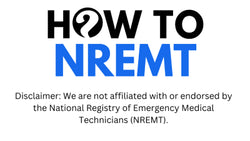As of July 1, 2024, the National Registry of Emergency Medical Technicians (NREMT) has rolled out substantial AEMT and Paramedic exam changes that reshape the certification process for Advanced Life Support (ALS) providers. These modifications, followed by similar updates to EMR and EMT exams on April 7, 2025, are designed to reflect the evolving demands of real-world EMS and emphasize clinical judgment and application over rote memorization. Let’s take a look at these changes and how our NREMT study test platform and resources can help you ace the new format.
1. Elimination of the Psychomotor Exam
One of the most impactful changes in 2024 is the complete removal of the separate psychomotor exam for AEMT and Paramedic levels.
What This Means:
·Now, certification relies solely on a comprehensive cognitive exam that incorporates clinical judgment elements.
·All hands-on (psychomotor) skill assessments are left to individual training institutions, which are still required to ensure students demonstrate proficiency in real-life scenarios.
Why This Matters:
·Reduces redundancy and simplifies logistics—no need to schedule and travel for two separate exams.
·Encourages uniformity across states and training programs by removing variation in practical testing standards.
·Gives students the flexibility to complete all training firstand then test when fully prepared.
Preparation Tip:
Focus your study efforts on mastering clinical reasoning and critical thinking rather than memorizing skill checklists.
2. New Exam Domains & Weight Distribution
The structure of the AEMT and Paramedic exams has been overhauled. Instead of scattered topic areas, the exams are now divided into six standardized content domains with defined weighting.
AEMT & Paramedic Domains (Effective July 1, 2024):
1. Airway, Respiration & Ventilation
2. Cardiology & Resuscitation
3. Trauma
4. Medical / Obstetrics / Gynecology (OBGYN)
5. EMS Operations
6. Clinical Judgment (New and heavily weighted)
Note: Pediatric content is integrated across all domains rather than treated as a standalone section.
Domain Weighting:
|
Domain |
AEMT (%) |
Paramedic (%) |
|
Airway, Respiration & Ventilation |
9–13% |
8–12% |
|
Cardiology & Resuscitation |
11–15% |
10–14% |
|
Trauma |
7–11% |
6–10% |
|
Medical / OBGYN |
25–29% |
24–28% |
|
EMS Operations |
6–10% |
8–12% |
|
Clinical Judgment |
31–35% |
34–38% |
Why This Matters:
These percentages reflect real-world EMS practice. For example, Clinical Judgment is now the most important domain, emphasizing the need for medics to think critically in dynamic, high-stress situations.
BLS Exam Updates (Effective April 7, 2025):
For EMR and EMT candidates, the exam domains are now aligned with patient encounter flow:
1. Scene Size-Up & Safety
2. Primary Assessment
3. Secondary Assessment
4. Patient Treatment & Transport
5. Operations
Pediatric Integration:
Across all levels, pediatric emergencies are now integrated into each domain to reflect how these patients appear in day-to-day EMS calls.

3. Technology-Enhanced Items (TEIs): Smarter, More Realistic Testing
TEIs represent a shift away from traditional multiple-choice questions and toward interactive, scenario-based assessments. They have now been fully incorporated into all certification levels.
What Are TEIs?
Technology-Enhanced Items require candidates to interact with the content:
·Drag-and-Drop: Organize procedures or body systems visually.
·Build-a-List: Arrange procedural steps in the correct order.
·Checkbox/Multiple Select: Choose all applicable answers in a table or paragraph.
·Clinical Judgment Scenarios: Multi-step case studies simulating a real EMS scene.
Why TEIs Matter:
·They test higher-order thinking: application, prioritization, and decision-making.
·They're now scored, not just trial or pilot questions.
·You’ll face multiple TEIs in your actual NREMT cognitive exam.
Study Tip:
Use our practice tools like NREMTcognitive exam practice simulators or apps that offer realistic TEI simulations. Regular multiple-choice practice won't be enough.
4. Exam Logistics: Fees, Timing, and Delivery Format
The exam format changes also come with revised testing logistics.
|
Level |
Fee |
Questions |
Time Limit |
Delivery Method |
|
AEMT |
$159 |
~135 |
3 hours |
Pearson VUE / OnVUE |
|
Paramedic |
$175 |
≥110 |
3.5 hours |
Pearson VUE / OnVUE |
|
EMT |
$104 |
70–120 |
2 hours |
Pearson VUE / OnVUE |
|
EMR |
$88 |
90–110 |
1 hr 45 min |
Pearson VUE / OnVUE |
Key Notes:
·Test delivery remains flexible, including remote proctoring via OnVUE.
·Question counts have increased to accommodate more complex TEIs and clinical judgment items.
·Retake and eligibility rules are unchanged.

How These Changes Affect Your Exam Strategy
If you’re preparing for the AEMT or Paramedic exam, these changes will significantly influence how you study.
·Memorization alone isn’t enough: You need to practice making decisions under pressure.
·Realistic practice tests matter more than ever: The new TEIs demand exposure to varied formats.
·Understanding national standards is key: State-specific protocols won’t help you on a national exam.
This is where we come in.
How We Help: The Best NREMT Paramedic Test Prep and More
At How To NREMT, our mission is to prepare EMS students at every level to pass their exams with confidence. Our platform is designed with the latest AEMT and Paramedic exam changes in mind. Here’s how we help:
NREMT Cognitive Exam Practice
Our 2,000+ practice questions replicate the structure and logic of the new exam format, including TEIs. Each question comes with rationales that help you understand not just what’s right but why it’s right.
Realistic Exam Simulation
We offer an exam simulator scored out of 1500—mirroring the new scoring system. It’s a critical tool to help you track readiness with precision.
AI-Powered NREMT Prep Tutor
Need help identifying your weak areas? Our AI tutor, "Mr. How To," provides personalized support and feedback 24/7. Think of it as your always-available paramedic tutor who never misses a beat.
Structured Training Plans
We provide a 10-step method that keeps your study structured and goal-oriented. No guesswork, just a path to success.
We offer live group coaching calls twice a month. For deeper preparation, our 7 or 14-day EMT and Paramedic Boot Camps provide intense, focused instruction tailored to the updated exam format.
Who Can Join?
Whether you’re a first-time test taker, someone who completed their training years ago, or a student struggling to pass on repeat attempts, our platform is built for you. We support:
·Paramedic students preparing for their first attempt under the new exam format
·Graduates of EMT programs transitioning to higher levels
·Individuals retaking the exam after one or more failed attempts
·Working professionals needing targeted prep due to lapsed certification
Our flexible online platform, mobile app, and expert tutor network make it possible to study at your pace—wherever you are in your EMS journey. We also offer 7 and 14 Days Paramedic Boot Camps for intense, focused preparation tailored to the updated exam format.

What This Means for Your Career
Passing the NREMT exam is more than a certificate—it’s your ticket to practicing as an EMS professional. These AEMT and Paramedic exam changes aim to raise the bar for patient care by demanding more from test takers.
With the right preparation, you won’t just pass—you’ll be ready to step into the field with skill and confidence. Our platform offers the best NREMT paramedic test prep tailored to the latest requirements, helping you build the decision-making skills employers value.
Frequently Asked Questions (FAQs)
Q1: Do I still need to take a psychomotor exam for AEMT or Paramedic certification?
A: No. As of July 1, 2024, the NREMT has eliminated the separate psychomotor exam for AEMT and Paramedic candidates. Certification is now based solely on the cognitive exam, which includes clinical judgment components that test decision-making through scenario-based questions.
Q2: What are Technology-Enhanced Items (TEIs), and how do I prepare for them?
A: TEIs are new interactive question formats introduced in 2024 for AEMT/Paramedic and in 2025 for EMR/EMT. They include drag-and-drop, build-a-list, checkbox/multi-select, and clinical judgment scenarios. These questions simulate real EMS field decisions. Practice with platforms like HowToNREMT.com, which mirror these question styles in their test prep tools.
Q3: What changes should EMTs and EMRs expect in 2025?
A: As of April 7, 2025, EMR and EMT exams will follow a new domain structure and include TEIs. The domains emphasize assessment, safety, treatment, and operations, with pediatric topics integrated throughout.
Q4: Why did the NREMT make these changes?
A: The updates stem from Practice Analyses conducted every five years to align exams with current EMS field duties. By eliminating outdated psychomotor exams and introducing TEIs, the NREMT is modernizing assessments to reflect the evolving skills and judgment required in real-world emergency care.
Q5: What’s the best way to prepare for these updated exams?
A: The best approach is to use up-to-date, targeted prep resources that reflect the new format and content domains. At HowToNREMT.com, we offer:
·NREMT cognitive exam practice
·Clinical judgment training
·Technology-Enhanced Item simulations
·The best paramedic test prep tools tailored to current standards

Don’t Face the AEMT and Paramedic Exam Changes Alone
These updates may seem overwhelming, but they’re also an opportunity to better showcase your readiness for real-world EMS work. Whether you’re a first-time tester or coming back stronger after a failed attempt, you don’t have to do it alone.
Join How To NREMT today and get access to the best tools, the most relevant NREMT cognitive exam practice, and expert guidance from our AEMT and paramedic tutor team. We’ll help you navigate the exam changes and walk into test day with clarity and confidence.
Ready to take the next step? Start your journey with How To NREMT today.

